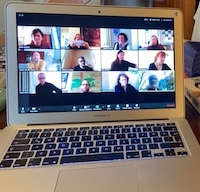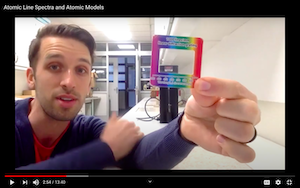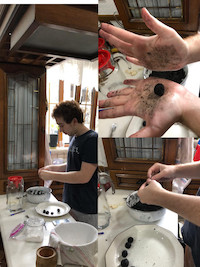Moving to Online Learning: RC Teachers Share Their Experiences
The RCQ asked RC teachers about their teaching experience, and their responses shed light on the surprises and challenges, as well as the funny instances of teaching online.

We went live with our distance learning experience on Monday, March 23 at 8:50 a.m. First lessons were awkward and slow. Microphones muted then unmuted and then muted again as people frantically gestured to you and mouthed, “I can’t hear you.” Students and teachers had to adapt to awkward conversations wherein people interrupted each other followed by long lags of silence. Teachers, like DJs, had to learn how to cue-up screens and video feeds while asking the students, “Can you see this Can you hear it? Can you hear me?” Faces, reduced to small boxes, froze often. Teachers and students looked at each other through screens, asking: “Are you okay? Are you well? What about your family?”
Teachers’ learning curve needed to be fast. Lesson planning for an on-line class requires new approaches and vast technological know-how. A whole new vocabulary was introduced: synchronous teaching, asynchronous teaching, Zoom meet, Zoombombing, Google Hangout, House Party, breakout rooms, screen share, and waiting rooms. The IT Department was and is on-call, supporting teachers and students to navigate these new methods of learning. Yet, nothing can prepare you for the physicality and draining nature of on-line learning. It requires long stretches of sitting, shoulders hunched, and eyes strained looking into the glare of a screen causing headaches, backaches, eye fatigue, and muscle cramps. All of us in need of stretch. All of us in need of a haircut.
Through it all, RC is showing its resiliency. There is laughter and moments of genuine communion as we help each other take each day as it comes. We escape the confines of our homes by using virtual backgrounds with colleagues teaching from space, the Caribbean, and students sitting next to Homer Simpson. We meet over movie nights, SC Corona Journals, and remote teas. We are keeping our spirits up with birthday shout-outs during Community Time and Music on Mondays concerts. All of us are thinking about the seniors, and we are celebrating the remarkable class of 2020 as they deserve.
The halls may be empty now, but the RC school spirit remains. We are together.
 Nathan Harris, Chemistry Teacher: “I’ve found small-group video conferencing to be one of my favorite tools.”
Nathan Harris, Chemistry Teacher: “I’ve found small-group video conferencing to be one of my favorite tools.”
We’re doing a mix of large group discussion, small group discussion and individual work in chemistry, the same major elements we would have been doing in person. I aim to have each of these elements in each class. Ideally, class begins and ends with around five minutes all together, more if we’re then typically watch a short video independently, then followed by work or discuss in small groups until we meet to summarize at the end of class.
We’ve been getting a lot of use from Edpuzzle, which allows teachers to annotate and add questions to online videos. There’s a temptation I think many teachers around the world are facing right now to just lean on videos created by professionals. We are doing our best to resist this and use a healthy percentage of our own content. My main contribution to this has been lab and demonstration videos. As a campus resident with access to the Feyyaz Berker labs, I’m able to set up and record practical chemistry videos. These have a very homemade feel, but I think this is one of their strengths. My hope is that they both tightly support what students are learning about and help them feel connected to their teachers and their school. Most or all material I am making is being used across chemistry classes, and I am routinely using notes and videos created by other teachers.
I’ve found small-group video conferencing to be one of my favorite tools. When students aren’t faced with a screen of 25 thumbnail videos, they talk much more naturally. I can join these small groups to answer questions or guide the discussion. Students are tired, but persevering. With everything that is strange and different right now, the important things are the same. Students like to see us, and see that we are working hard and care about them and what they are learning. The converse is also true. I’m encouraged to see their faces on my laptop. It’s heartening to see students smiling, working hard, and making the best of a challenging situation.
 Maria Sezer, Art Teacher: “Since every house has a kitchen, having my students cook seemed the best solution to me.”
Maria Sezer, Art Teacher: “Since every house has a kitchen, having my students cook seemed the best solution to me.”
When I heard that we were planning for online teaching, I was flabbergasted: How can I do ceramics on-line with my students, who will not have clay or tools at home? Quickly it became apparent I had to look for an alternative, something each person could do in their house. Since every house has a kitchen, having my students cook seemed the best solution to me. Cooking requires research, planning, fine hand coordination and aesthetic presentation, which are quite parallel to things we do in ceramics. Besides that, in a time of crisis, I hoped to bring family members together and for my students to be a help around the house, and food always comforts. Photographs of the process, the final product and a cleaned-up kitchen were to be posted onto the classroom.
Again, my RC students amazed me! Most of them clearly enjoyed their tasks and I heard many heartwarming stories of students learning about how to do certain dishes from dads, mothers and grandmothers. While online we discussed technical questions as to whether adding an egg to the dough would make the dough less brittle and easier to shape. I learned of new ingredients like spirulina for some of my students started making variations on dishes. A student told me that her rondo blender was giving her happiness each day. Sometimes I heard of fierce judgements from grandmothers who were not easy to please, and we had good laughs about them! Of the vegetable dishes, mücver was most popular in all kinds of shapes and ways. But I also received pictures of sarma, or celery root with quince and orange juice - no small feat. I learned of a new Korean vegetable dish called bibimpap. Or veggie rolls Japanese style. For sweets, semolina was the most popular for making irmik tatlısı, but family members had birthdays and were surprised by some amazing San Sebastian cheesecakes as well! One student made Tanguyan, a Chinese sweet consisting of rice balls stuffed with crushed sesame seeds, floating in a sweet juice. Bravo to all of them and the support they received from their families.